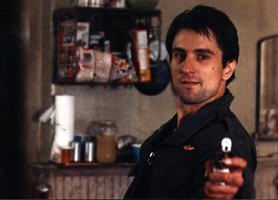



Imagine Hitchcock's Psycho told from the point of view of its title character, and you have a rough idea of Taxi Driver. This riveting 1976 film is at once a thriller, a psychological case study, an exploration of the eroticism of violence, a political commentary and a horror melodrama of seamy New York. It was also a turning point in the careers of all its principal creators: director, Martin Scorsese; the screenwriter, Paul Schrader; the star, Robert De Niro; and, then, very young featured actress, Jodie Foster. The Scorsese-Schrader collaboration has persisted through the equally controversial The Last Temptation of Christ. The Scorsese-De Niro connection, perhaps one of the most important director-actor relationships of modern American cinema, would continue to bear fruit in such movies as New York, New York, The King of Comedy and, of course, Raging Bull.
In Taxi Driver, De Niro plays Travis Bickle, a 26-year-old ex-Marine who takes a job driving a New York cab on 12-hour shifts because he can't get to sleep. Unlike his peers, he will take anyone anywhere, and he cruises the neighborhoods where, as he puts it, "all the animals come out at night -- whores . . . queens, fairies, dopers, junkies. . ." When Travis takes his car back to the garage at daybreak, he often finds that he has "to clean the come off the back seat." Sometimes there is blood to be cleaned up as well.
Travis looks like a normal, average man -- a faceless face in the crowd -- but he just doesn't have the ability to connect with conventional patterns of reality, to become socialized. He exists beyond the boundaries of civilization, even though he moves within it. He has no friends and is desperately lonely. He doesn't know the meaning of some common words. He lives in a grimy hovel, littered with junk food wrappers and porno magazines. "I believe one should become a person like other people," he writes in a tattered composition book diary. "I've got to get organized." Taxi Driver is the story of how Travis gets "organized" -- how he makes himself into a person out of his scattered scraps of information about life as gleaned from the nocturnal undergrounds of the city.
His search for routes into conventional existence leads him into the short-lived pursuit of a chic, upper-middle-class campaign worker (Cybill Shepherd) for a vacuous presidential candidate (Leonard Harris) and then into the attempted rescue of a 12-1/2-yearold prostitute (Foster) who works for a pimp (Harvey Keitel) on the Lower East Side. When all else fails, Travis fixates on the grotesque New York of his fares (one of the most frightening of whom is played by Scorsese) and decides to play his own role in urban betterment by helping to "wash all the scum off the streets." What follows is a random, irrational bloodbath that leads to an even more shocking epilogue. By its final credits, Taxi Driver has reminded us that, depending on the public's and the media's mood, a Charles Manson or Charles Whitman or John Hinckley can also become an American hero -- as exemplified by the idolatrous followings of My Lai's William Calley and New York's subway vigilante, Bernhard Goetz.

Scorsese's cast, which also includes Peter Boyle and Albert Brooks, is as gritty as his locales, and his mesmerizing cinematic style changes as Travis' character does. At first the film's pace is languorous, with repeated images suggesting the monotony of Travis' routine. When the cabbie's plan for "total reorganization" begins, the movie tightens along with Travis' body and sense of mission. The slaughter sequence of Taxi Driver has the release of a sexual orgasm, and it is carefully anticipated by the voluptuousness of the visual imagery that comes before. This movie's view of New York City is that of a fever dream, as refracted through the voyeuristic perspective of a rear-view mirror. Rain pours out of the gloomy night skies, steam rises in gusts from pavements, fire hydrants erupt in geysers, an AlkaSeltzer tablet explodes close-up in a glass of water -- until finally there can only be a hurricane of blood. The pent-up tension is accentuated by Bernard Herrmann's jazzy score, which finds its release in Hitchcockian horror only in the final reel.
Seen in the early 1990s, the Manhattan of Taxi Driver occasionally looks antique. The landmark cabbies' hangout, the Belmore Cafeteria, is gone now, and so, for that matter, are Checker cabs. But Scorsese's images -- of a young prostitute's bedroom aglow with incongruous sacramental candles, of De Niro's brain silently snapping from psychic collapse -- are enduring. And so, sad to say, is this movie's still-timely vision of an irrational urban American hell on the brink of violent apocalypse.
-- FRANK RICH
Credits
Director: Martin Scorsese
Producers: Michael Phillips, Julia Phillips
Associate Producer: Phillip M. Goldfarb
Writer: Paul Schrader
Director of Photography: Michael Chapman
Supervising Film Editor: Marcia Lucas
Film Editors: Tom Rolf, A.C.E., Melvin Shapiro
Art Direction: Charles Rosen
Music: Bernard Herrmann
Costume Designer: Ruth Morley
Visual Consultant: David Nichols
Transfer
This edition of Taxi Driver was transferred digitally from a 35mm interpositive in its correct aspect ratio of 1.85:1. The soundtrack was mastered from a 3-track mono magnetic master.
